Contents
- Aklai Devi Mandir
- Akluj Fort
- Ardhanari Nateshwar Mandir
- Armor Museum (Fatehsinh Mahal, New Royal Palace)
- Bhagwant Mandir
- Bhuikot Fort
- Early Inscription of the Yadava Dynasty in Mahim
- Early Settlement Site at Narkhed
- Ganesh Panchayatan Mandir
- Guru Nanak Darbar
- Kamala Bhavani Mandir
- Nagnath Mandir
- Rajeray Math
- Roopa Bhavani Mandir
- Siddheshwar Mandir, Machnur
- Siddheshwar Mandir, Solapur City
- Shivpuri: A Land of Sacred Agnihotra and Yagnya Rituals
- Shivpuri Agnihotra Ashram
- Shri Harihareshwar Mandir
- Shri Kashi Vishweshwar Mandir
- Shri Khandoba Mandir
- Shri Sangameshwar Mandir
- Shri Vitthal Rukmini Mandir
- Vatavruksha Shri Swami Samartha Maharaj Mandir
- Veer Tapasvi Math
- Sources
SOLAPUR
Cultural Sites
Last updated on 6 November 2025. Help us improve the information on this page by clicking on suggest edits or writing to us.
Aklai Devi Mandir
Aklai Devi Mandir is located about 2 km from Akluj, on the banks of the river Nira. The town of Akluj itself is named after the Devi. The Mandir, originally a modest mud structure, is believed to date back 1000-1200 years, with historical references found in the Kashi region. According to local legend, the rakshas sadhu Ankaleshwar troubled the sadhus and pandits of the area, prompting them to invoke Devi Parvati. In response, she took the form of Aklai Devi to vanquish him, marking the origins of the Mandir.
![An exterior view of the Aklai Devi Mandir, Akluj, Solapur.[1]](/media/culture/images/maharashtra/solapur/cultural-sites/an-exterior-view-of-the-aklai-devi-man_zLFX590.png)
The discovery of the murti of Aklai Devi is steeped in folklore; villagers found it when a cow stepped on something hard while grazing. Upon investigation, they unearthed the murti, which was then installed in Akluj. Local legends, alongside historical records, suggest that Akluj has been significant throughout the Yadav and Chhatrapati eras, indicating the Mandir’s long-standing importance.
![The murti of Aklai Devi at the Aklai Devi Mandir.[2]](/media/culture/images/maharashtra/solapur/cultural-sites/the-murti-of-aklai-devi-at-the-aklai-d_3dmfvFO.jpg)
The Mandir is particularly significant during Navratri, with various programs held over the nine days of Ashwin Shuddh Navratri. On Kojagiri Poornima, the murti of the Devi is adorned with milk offerings to awaken her from sleep, followed by the distribution of Mahaprasad to villagers.
Akluj Fort
Akluj in Solapur is steeped in historical significance within Marathi culture, having witnessed numerous battles and pivotal events. The river Nira historically marked the boundary between the Nizamshahi dynasty of Ahmednagar and the Adilshahi dynasty of Bijapur. Notably, Emperor Aurangzeb crossed this river by boat during his travels, emphasizing its strategic importance. Today, the Akluj Fort is located on the river’s banks as a legacy to these historical narratives.
The fort has been carefully preserved and renovated, notably under the guidance of Shivshahir Babasaheb Purandare and skilled sculptors like Dinkarrao and Avinash Thopte. A section of the fort, called Shivsrushti, showcases the life of Chhatrapati Shivaji Maharaj through intricate sculptures and murals. Visitors can explore replicas that provide insights into the living standards during Shivaji’s era.
As one wanders through the fort, they encounter captivating features, including statues of elephants and horse-mounted soldiers made from durable synthetic fiber. Murals along the fort walls depict key moments from Shivaji’s life, from his birth to his crowning ceremony. The bastion named ‘Upalya’, situated in the fort’s center, features a statue of Shivaji and likely served as a strategic lookout point, offering panoramic views of the surroundings.
![A view of the equestrian statue of Chhatrapati Shivaji Maharaj on a bastion of Akluj Fort, Akluj, Solapur.[3]](/media/culture/images/maharashtra/solapur/cultural-sites/a-view-of-the-equestrian-statue-of-chh_udLKzRt.png)
The fort walls are adorned with murals honoring Maratha soldiers from various sects and religions, including Tofchi, Mashaalji, Tirandaaj, Paharekari, and Ramoshi. As visitors approach the entrance, they can explore a museum displaying detailed models of notable forts, such as Rajgad, Raigad, Vijaydurg, Sindhudurg, Pratapgad, and Devgiri, all crafted from synthetic fiber, showcasing the military architecture of the period.
The area surrounding the fort is equally enchanting, featuring lush greenery, vibrant flowers, and tranquil fountains. A path along the riverbank and bastion invites visitors to discover ancient remnants and Veergals, further enhancing the historical experience offered by Akluj Fort.
Ardhanari Nateshwar Mandir
The Ardhanari Nateshwar Mandir is situated in Velapur, within the Malshiras taluka of Solapur district. It is renowned for its annual yatra of Shri Ardhnari Nateswara, the village kuldevta, which occurs on Chaitra Poornima. Celebrations include various events like Shuddha Panchmis Haldi, Ashtamis Lagna, Pournimes Varat, and Vadya Ashtamis Solavi, featuring competitions that have contributed to Velapur’s fame, especially during the Yadava period.
![The Ardhanari Nateshwar Mandir in Velapur is a well-structured complex made out of huge rocks.[4]](/media/culture/images/maharashtra/solapur/cultural-sites/the-ardhanari-nateshwar-mandir-in-vela_DNi6TP5.jpg)
Historically, the Velapur area was significant during the Yadava dynasty of Devagiri. Although the name has remained unchanged over the years, the town was known initially as Ekachakranagar, dating back to the Mahabharat era, around five thousand years ago. This region, part of the Dandakaranya forest, was home to notable sadhus, including Rishi Shandilya. While there are no direct historical records from the Mahabharat regarding Velapur, archaeological evidence from around 1300 CE has been found. ‘Velapur’ signifies its role as the southern boundary of Devagiri, with ‘vel’ meaning boundary and ‘pur’ meaning village by the riverbank. Velapur served as a sub-capital for the Yadavas, functioning as a military and administrative hub.
Also known as the Hara Nareshwara Mandir, it was built in the 12th century CE during the Yadava Dynasty under King Ramchandra Dev. It showcases Hemadpanthi-style architecture and intricate carvings crafted by the brothers Bramhadev and Baidev Raina. Krishnadevaraya later renovated the Mandir in the 13th century CE, as indicated by inscriptions on its walls and staircases; it also includes the installation of two facing Nandi statues, a unique feature.
Visitors to Velapur can explore the historic Ardhanari Nateshwar Mandir, famed for its distinctive murti depicting Mahadev on the right and Devi Parvati on the left. Adjacent to this murti is a stone featuring carvings of allegorical animals like a bull and a lion, their respective vahanas. The mandir complex also contains another sanctuary to Shiv and sculptures of other devtas such as Hanuman and Bhairav, with a large square water tank nearby, offering a peaceful spot for meditation. The mandir, constructed from rock, presents a rustic, sepia-toned appearance.
Armor Museum (Fatehsinh Mahal, New Royal Palace)
Located in Akkalkot, the Akkalkot New Royal Palace, known as Fatesingh Mahal, houses Asia’s largest Armor Museum, featuring an impressive collection of artifacts, remnants, and elegant works. Among the exhibits are various utensils, coins, precious stones, ivory items, small toys, and unique vehicles imported from England, as well as an array of weapons.
The museum also showcases decorative items, including a chandelier made from ostrich eggs and a musical instrument crafted from Indian bison horns. Notably, it includes protection shields made from turtle shells and taxidermy or stuffed specimens of wild animals like tigers, leopards, blackbucks, wild boars, bears, deer, and sambars.
![An exterior view of the Armor Museum at Akkalkot.[5]](/media/culture/images/maharashtra/solapur/cultural-sites/an-exterior-view-of-the-armor-museum-a_NSAlDd9.png)
Built over a century ago by Maharaj Fatesingh III of Akkalkot, the palace features a round iron staircase for easy access. Also known as Shrimant Fatesingh Maharaj Bhonsle, he is remembered for his bravery and leadership; he significantly contributed to the cultural and social development of Akkalkot.
During World War I, Maharaja Fatesingh III, only 18 years old at the time, fought alongside the British. After returning to India due to health issues, he was honored for his bravery and requested that the weapons used by his soldiers be returned. The British agreed, but they sabotaged the guns before sending them, fearing he might use them against their forces.
Determined to create a fitting tribute, Maharaja Fatesingh III built the Fatesingh Mahal and the Armor Museum, systematically arranging the millions of old weapons inherited from his ancestors. The arsenal includes thousands of swords, spears, axes, cutlasses, guns, and arrows, displayed in artistic formations resembling the rising and setting sun.
Among the unique items in the museum is the Gajasan, the king’s throne made from real elephant legs instead of wooden supports, which remains on display in Akkalkot. Visitors can also view daily-use items such as clothing, armor, and other artifacts associated with the kings of Akkalkot.
The current Maharaj of Akkalkot Sansthan is Shrimant Malojiraje Bhosale III, who diligently oversees the affairs of the Sansthan. Revered for his discipline and compassion, Rajasaheb is known for his kindness and support, often assisting those who seek help with academic or regional issues.
Bhagwant Mandir
Bhagwant Mandir is located in Barshi, Solapur district, and is dedicated to Shri Vishnu, worshipped here in the unique form of Bhagwant. It is believed to be the only Mandir in India where Shri Vishnu is revered under the name Bhagwant. The Mandir was constructed in 1245 CE in the Hemadpanti architectural style and has four entrances, with the main entrance facing east.
![Exterior view of the Bhagwant Mandir in Barshi taluka, Solapur district.[6]](/media/culture/images/maharashtra/solapur/cultural-sites/exterior-view-of-the-bhagwant-mandir-i_Y0V9tM6.png)
Inside the garbhagriha (sanctum), the black stone murti of Shri Bhagwant holds the shankh (conch), chakra (discus), and gada (mace), with a carved image of his bhakt, king Ambrish, beneath the right hand. Behind the murti is an image of Shri Lakshmi, while a Shivling is carved on the forehead. Marks representing the footsteps of Bhrigu Rishi are also seen on the chest of the murti. In front of the garbhagriha stands a Garudkhamb.
Historical records mention grants made to the Mandir by Nanasaheb Peshwe in 1760, the East India Company in 1823, and the British Government in 1784. Bhagwant Mandir is especially known for its Ekadashi celebrations in the Hindu months of Chaitra (March-April), Magh (January-February), Ashadh (June-July), and Kartik (October-November). On Ashadhi and Kartiki Ekadashi, a grand procession is held, carrying the Bhagwant on a Garuda through the town. A smaller procession, or chabina, is also held every full moon.
Bhuikot Fort
Bhuikot Fort is a prominent attraction in the district, beautifully situated near the lake of Siddheshwar Mandir, surrounded by water on the east and solidly constructed on three sides. The entrance features a large, sturdy door known as Hatti Darwaza, made of iron and wood. Construction of the fort began in 1313 CE during ‘Bhadrapada Ashtami’ on a Wednesday.
![The Bhuikot Fort, near the Siddheshwar Mandir, is a blend of Islamic and Maratha fort architecture.[7]](/media/culture/images/maharashtra/solapur/cultural-sites/the-bhuikot-fort-near-the-siddheshwar-_8HaBJqN.png)
Notably, Emperor Aurangzeb is said to have stayed there for a year during his rule. The fort charges an entry fee and is conveniently located near the railway station and bus stand. A garden surrounds the fort, providing a space for children, youth, and the elderly to play and walk. With a history spanning around 700 years, it remains a fascinating site for visitors.
Early Inscription of the Yadava Dynasty in Mahim
The inscription is a 13th-century stone record located in Mahim village, Sangola taluka, Solapur district. Carved in 1269 CE during the reign of Yadava king Mahadevaraya, it records the donation of twenty gold coins (gadyanas) for a Mandir in the village. The inscription was found embedded in a wall behind the ST bus stand, with a broken fragment discovered near the local school.
The inscription contains 22 lines of text, starting in Sanskrit and gradually shifting to early Marathi, reflecting the gradual adoption of Marathi as an administrative language under the Yadavas. The text includes genealogical praise of Mahadevaraya, mentions his descent from Vishnu, and warns of curses for disrupting the donation. Typical symbols of Yadava inscriptions — a sun, moon, sword, and cow with calf are carved on the slab.
Mahim village lies in the Bhima River basin and was part of the Yadava kingdom based at Devagiri (Daulatabad). The inscription is significant as one of the earliest surviving Yadava-period records in Solapur district. As of now, it remains exposed to the weather and has yet to receive formal protection or conservation.
Early Settlement Site at Narkhed
Narkhed village in Mohol taluka of Solapur district holds a remarkable place in history. Dhaval Kulkarni (2023), writing for India Today, reveals that Solapur’s human habitation dates back to the Pre-Satavahana period, around 400 BCE. Excavations in Narkhed uncovered ancient granaries or storage pits, believed to have stored grains and spices between 400 and 300 BCE, marking them as some of Maharashtra’s oldest discoveries and highlighting Solapur as one of the state’s earliest settlement sites.
Around 2019-20, archaeologists from Punyashlok Ahilyadevi Holkar Solapur University excavated a settlement in Narkhed, covering the transition from the Pre-Satavahana to the Satavahana era (c. 4th-3rd century BCE). Maya Patil (Shahapurkar), Head of the Archaeology Department, noted the discovery of an underground grain storage system, called ‘pev’ in Marathi. This structure, about 20 ft. deep and 4 ft. wide, adds further significance to the area’s historical importance. A comprehensive report on these findings is awaited.
![Underground storage pits found at Narkhed, Solapur.[8]](/media/culture/images/maharashtra/solapur/cultural-sites/underground-storage-pits-found-at-nark_IYjHFkW.png)
Ganesh Panchayatan Mandir
The Ganesh Panchayatan Mandir in Akkalkot, built by the Bhosale Royal Family, holds a significant place in the community. Historically, the townspeople celebrated Ganesh Chaturthi here, with a Mirvanuk of Ganpati adorning the town.

This mandir is also notable as the site where Shrimant Malojiraje Bhosale II, the King of Akkalkot and a devoted follower of Swami Samarth Maharaj, first met the revered sant.
Shri Swami Samarth gifted the ‘Suryamani’ and ‘Paduka’ to Akkalkot Rajasaheb Shrimant Malojiraje II for the celebration of Guru Pratipada. These divine items are now enshrined in the Ganesh Panchayatan mandir on Guru Purnima, allowing bhakts to seek the blessings of Shri Swami Maharaj. After being closed for an extended period, the Mandir has recently begun to attract visitors, with increased foot traffic on weekends.
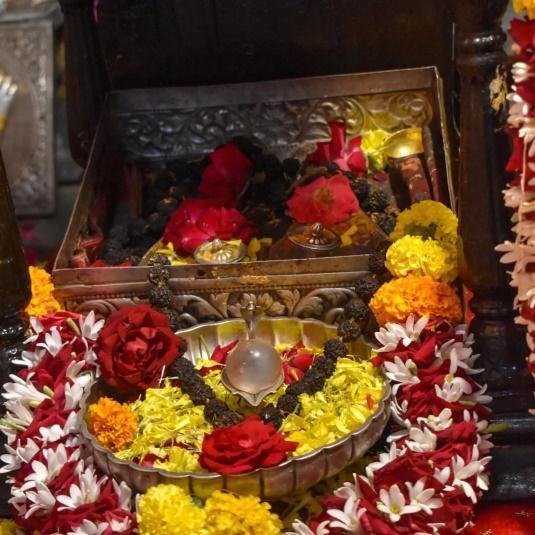
Guru Nanak Darbar
Guru Nanak Darbar, located in Antrolikar Nagar, was established in 2012 and named after the first Sikh guru, Guru Nanak; it is a welcoming space for all, closely associated with the Sikh community. Visitors, regardless of their religion, can see the darbar in a clean, well-maintained environment.
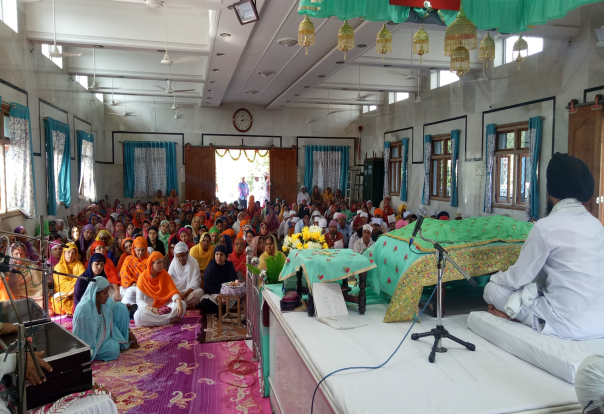
The best time to visit is during Guru Nanak Jayanti and Baisakhi. Visitors often bring offerings of grains, sweets, and other food items. Daily Satsang sessions take place each morning and evening, fostering a sense of community and devotion.
Kamala Bhavani Mandir
Located in Karmala, the Shri Kamala Bhavani Mandir was constructed in 1727 CE by Maratha Hindu Jayawant Bahadur Maharaja Shrimant Raja Rao Rambha Naik Nimbalkar Paramara, and is recognized as the second seat of Tulja Bhavani of Tuljapur. Built in the Hemadpanthi style, the Mandir features entry doors facing east, south, and north, with a distinctive architecture that includes 96 steps leading to the entrance.
![View of the Kamala Bhavani Mandir in Karmala, Solapur.[9]](/media/culture/images/maharashtra/solapur/cultural-sites/view-of-the-kamala-bhavani-mandir-in-k_PhsXsaM.png)
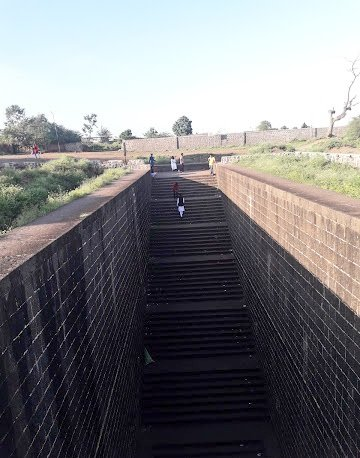
Inside, the Mandir is supported by 96 pillars, and its top showcases 96 pictures and 96 ‘Overyas’ (ornamental features). This emphasis on the number 96 pays tribute to the 96 Kulin Maratha Kshatriyas and reflects the legendary division of Bharatvarsha into 96 mandalas under the Maratha Dharma Kings. Additionally, a special Maratha step-well with 96 steps honors the Shahana Kulin Bhupalas.
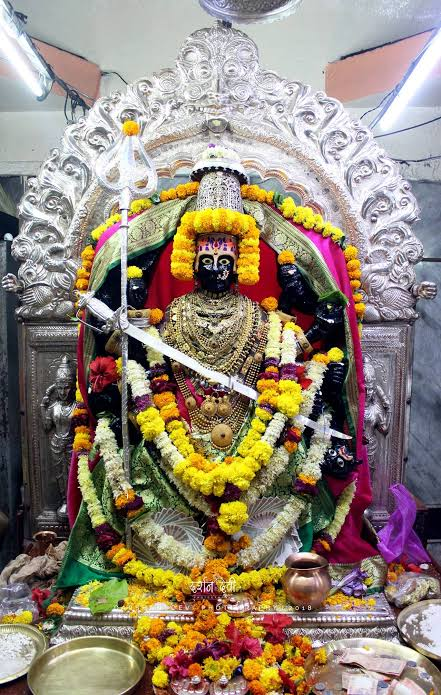
Nagnath Mandir
The Nagnath Mandir in Wadwal village, Mohol taluka, is an ancient Hemadpanthi Mandir. According to legend, Shiv took the form of Nagnath in the 11th century and is believed to have taken water samadhi at Khargatirtha, making Wadwal a spiritually significant site.
The story goes that Nagnath appeared near Manasarovar and, while traveling to Kashi, dug a large pit in Wadwal using a weapon called kharg. He then filled this pit with water from the river Ganga, and today a spring of fresh water can be found there, marked by a wall known as Binda; this site is called Khargatirtha in honor of the kharg. Another legend tells of Hegde, a disciple of Nagnath, who offered his head as Gurudakshina. It is believed that he and Nagnath reunite every year on Chaitra Purnima.
In Mohol, Nagnath faced harassment from villagers, prompting him to seek refuge under a tree in a grove. Miraculously, the dried tree bloomed with palvi flowers where he rested, giving the village its name ‘Wadwal’. A banyan tree planted by Nagnath also stands nearby; although it fell, it sprouted again when watered by his disciples, making it a popular tourist spot.
![The murti at the Nagnath Mandir, Wadwal, Solapur.[10]](/media/culture/images/maharashtra/solapur/cultural-sites/the-murti-at-the-nagnath-mandir-wadwal_L0axlr2.jpg)
Historically, Mohol was considered Nagnath’s home before he moved to Wadwal, about 5 miles southeast. Mandirs dedicated to Nagnath in both Magh Mohol and Wadwal were built in 1730 by Ghongro, a prosperous merchant from Vairag.
Rajeray Math
The Rajeray Math, located near the Ram Mandir in Akkalkot, is a significant spiritual site established in 1877 under the guidance of Swami Samarth Maharaj. The math is renowned for housing the divine foot impressions (Chaitanya Paduka) of Maharaj, intricately carved on stone and adorned with symbols of a shankh (conch shell), padma (lotus), and kamandal (water pot), radiating a golden glow. Bhakts believe that taking tirtha (holy water) from these padukas brings healing, and bowing before them fulfills one's wishes.
Over time, the original Chunae Gacchi Math fell into disrepair until Belanath Maharaj, who resembled Shri Sai Baba, restored it. Today, his tomb stands in front of the math, marking his contribution to preserving this sacred site.
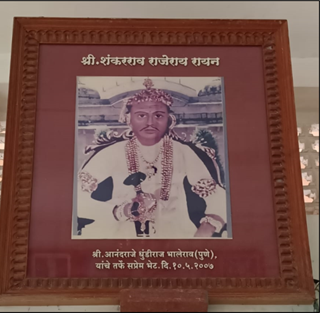
The origins of the math trace back to Shankarrao Rajeray, a Jahagirdar from the Hyderabad Sansthan, who suffered from leprosy and other ailments. Possessing six lakh suvarna mudras (gold coins), he sought divine intervention and was directed in a vision to Akkalkot, where he witnessed the Maharaj’s miracles under a banyan tree. Following Maharaj’s guidance, he was led to Nasir-ud-Din Dargah, where he received a life-saving remedy, which was consuming seven black peppers with lemon juice. Grateful for his miraculous cure, Rajeray funded the math’s construction with ten thousand suvarna mudras.

Roopa Bhavani Mandir
Located in the Bhavani Peth area of Solapur, the Mandir of Roop Bhavani has an interesting story attached to it. Around 125 to 150 years ago, Pujari Bandoba worked as a farm laborer for Deepak Shah, the then landowner. A devoted follower of Tulja Bhavani, Bandoba discovered a murti while plowing a wasteland. He envisioned it as the form of Tulja Bhavani and named it Roopa Bhavani. Since then, regular Abhishek Naivedya Puja has honored Sri Roopa Bhavani Devi, with the stewardship passed down through five generations of Bandoba’s descendants. Two daily Abhisheks and Chabina ceremonies every Tuesday and on Poornima take place at the Mandir.
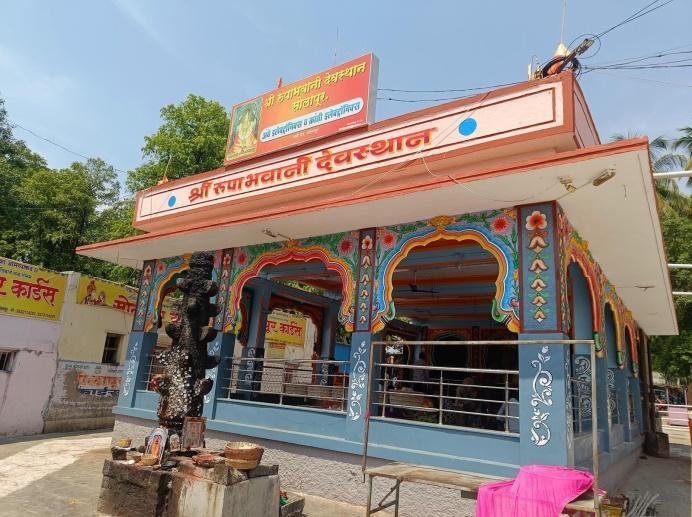
The festivals of Navratri and Dussehra are celebrated with great pomp, attracting nearly a million visitors passing through Tuljapur. Pilgrims from Karnataka, Andhra Pradesh, and Solapur often bring offerings like coconuts, oil, sarees, and garlands, as noted by Pramod Pawar, the Mandir pujari.
Siddheshwar Mandir, Machnur
Machnur village in Mangalvedhe taluka is renowned for the Siddheshwar mandir located by the river Bhima, where sadhus once practiced spiritual rituals. The beautiful ghat on the riverbank is said to have been constructed by Punyashlok Ahilyabai Holkar, and nearby lies the Jateshwar mandir. Upon entering the mandir complex, the Mallikarjun mandir is on the left, while Baba Maharaj Arvikar’s Math is on the right.
![The Siddheshwar Mandir at Machnur village, Mangalvedhe taluka.[11]](/media/culture/images/maharashtra/solapur/cultural-sites/the-siddheshwar-mandir-at-machnur-vill_6J86FGC.jpg)
The village’s name is tied to a fascinating story involving the Machnur Fort, built by Mughal Emperor Aurangzeb in 1695 CE for protection against Maratha attacks. After taking control of the area, Aurangzeb ordered the destruction of a Shivling, but his soldiers were thwarted by a swarm of bees. In a fit of anger, Aurangzeb sent a disrespectful offering of beef wrapped in cloth, which miraculously transformed into white flowers when uncovered. This incident led to the fort’s original name, ‘Maas-Noor’, which later evolved into ‘Machnur’. Ashamed of his actions, Aurangzeb began making annual donations to the Mandir, a tradition that continues today with the Maharashtra Government contributing ₹480 yearly.
Near the Math is Aurangzeb’s fortress, where he initiated the Rudrabhishek ceremony during the month of Shravan. Brahmins were appointed to perform rituals, with Aurangzeb providing financial support for these religious activities.
![The ruins of Machnur Fort in Machnur, Mangalvedhe taluka, Solapur district.[12]](/media/culture/images/maharashtra/solapur/cultural-sites/the-ruins-of-machnur-fort-in-machnur-m_pNovpQD.png)
The puja at Siddheshwar Mandir involves the local Muslim community playing nagada drums, while the Gurav community from Brahmapuri also holds the Mandir’s rituals in high regard, adjusting their worship practices every second Wednesday. Aurangzeb spent four years at this camp, overseeing administration for Delhi, and notable sants like Shankaracharya, Swami Samarth, Sitaram Maharaj, and Baba Maharaj Arvikar have also visited this sacred site.
Siddheshwar Mandir, Solapur City
Located in the Siddheshwar Mandir Area in Solapur city, the Siddeshwar Mandir was built by Yogi Shri Siddharameshwar and is dedicated to Sant Siddheshwar, a revered bhakt of Bhagwan Shiv and the gramdevta of Solapur. Siddheshwar attained samadhi at this site, marked by a marble samadhi at the Mandir’s center. Since 1899, this site has been managed by the Shri Siddheshwar Devasthan Panch Committee.
![Lake within the Siddheshwar Mandir complex in the Siddheshwar Mandir Area, Solapur.[13]](/media/culture/images/maharashtra/solapur/cultural-sites/lake-within-the-siddheshwar-mandir-com_6Lg48SV.png)
The best time to visit is during the Makar Sankranti festival in mid-January, when grand celebrations unfold over three days. A local jatra called Gadda Jatra takes place for 15 days near the Mandir during this period.
Shivpuri: A Land of Sacred Agnihotra and Yagnya Rituals
Shivpuri, also known as Yagnapuri, located near Akkalkot in Solapur district, is significant for performing Yagnas, or sacred fire ceremonies rooted in ancient Vedic tradition. These rituals are believed to invoke divine blessings, purify and elevate the spirit, and bring harmony to individuals and communities. The spiritual vibrations generated during these ceremonies are thought to have profound healing effects. The practice of Agnihotra, as it is known today, was revived in 1942 by Shri Gajanan Maharaj, a disciple of Shri Gangadhar Maharaj, who was himself a follower of Shri Swami Samarth. Inspired by a vision of Bhagwan Parshuram, Shri Gajanan Maharaj standardized Agnihotra to be performed precisely at sunrise and sunset, lasting five to ten minutes.
A landmark event was the first Maha Somayagnya organized by Shri Gajanan Maharaj in 1969, following Vedic philosophy with an emphasis on non-violent offerings of ghee and grains. To further this revival, he convened a Vid Vatta Sabha to educate scholars about Vedic Yagnyas. The Yagnya Stambha, a 40-foot-tall stone pillar standing before the Yagnya Vedi, commemorates the Maha Somayagnya’s Purna Ahuti. It bears marble plaques inscribed with Shreeji’s teachings and marks the beginning of a harmonious era. Even today, daily Yagnas are performed at sunrise and sunset at Shivpuri, attracting both locals and visitors. The Agnihotra tradition has also spread beyond Shivpuri, with many households conducting these rituals at designated times.
![The Yagnya Stambh at the Shivpuri Agnihotra Ashram.[14]](/media/culture/images/maharashtra/solapur/cultural-sites/the-yagnya-stambh-at-the-shivpuri-agni_B37qg5V.png)
Shivpuri Agnihotra Ashram
Located in Shivpuri, Shivpuri Agnihotra Ashram is an important site associated with Shri Gajanan Maharaj, a disciple of Shri Swami Samarth, and his father, Shri Swami Shivanand Yogindra Maharaj. Shivanand Maharaj, a highly esteemed Nada Brahma Yogi, embodied the concept of Shabda Brahma, the primordial word representing creation and divinity. Regarded as an incarnation of Jamadagni, a sadhu from the Bhrugu Dynasty, Shivanand Maharaj symbolized eternal bliss through his very name, meaning ‘fire that brings eternal bliss’. Known for his extraordinary yogic abilities, his rhythmic breathing was often accompanied by the chant of Omkar Mantras. While tending to the sacred fire at Shivpuri, he famously proclaimed, “Death shall not conquer us.” The site itself, blessed during Swami Samarth’s travels, was marked by hymns in praise of Mahadev and foreseen as a future center of purity and knowledge.
![The interior of the main Mandir in the Shivpuri Agnihotra Ashram at Shivpuri, Solapur.[15]](/media/culture/images/maharashtra/solapur/cultural-sites/the-interior-of-the-main-mandir-in-the_kUbNsKC.png)
Inspired by auspicious signs, Shri Gajanan Maharaj acquired the land in 1953 and named it Shivpuri, symbolizing a new era of science, brotherhood, and peace. He referred to it as Bhu Kailasa, a place of purity and healing. Shivpuri is now the global headquarters of the Vishwa Foundation, spanning 150 acres of organic farms and Ayurvedic plantations. Thousands of visitors come here each year seeking spiritual teachings and healing, with the community providing modern accommodations for those attending courses, retreats, and events. The foundation is currently overseen by Dr. Purushottamji Shrikantji Maharaj Rajimwale, grandson of Shri Gajanan Maharaj, who also holds a Master’s degree in Ayurveda.
Overall, Shivpuri stands as a vibrant centre of spiritual and cultural practice, dedicated to promoting peace, unity, and well-being.
Shri Harihareshwar Mandir
The Shri Harihareshwar Mandir, located in Kudal Hattarsang village, is unique in that it unites bhakts of both Vishnu (Hari) and Shiv (Har), emphasizing the principle of one superior divinity. Notably, it is the only west-facing Mandir and features two garbhagrihas, one dedicated to Vishnu and the other to Shiv, symbolizing the convergence of the Vaishnavism and Shaivism sects.
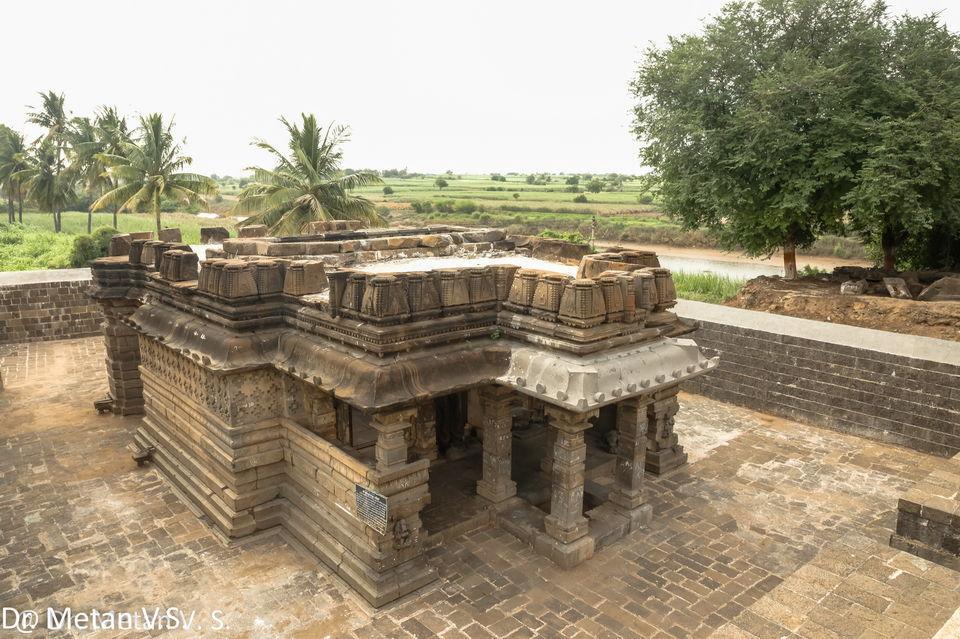
Dating back to the Chalukya period, the Mandir was excavated by Professor Gajanan Bhide and his students from Dayanand College, Solapur. During the restoration, Vilas Wahane, Assistant Director of the Maharashtra State Department of Archaeology, revealed that the project had a total budget of ₹1.75 crores.
One of the Mandir’s most remarkable features is the Bahumukhi (multi-faced) Shivling, which boasts 359 intricately carved facial expressions in the stone, with a circumference of 4 meters. This impressive craftsmanship is unparalleled in any ancient Mandir in India, making it a significant highlight of the site.
![At the Harihareshwar Mandir, the Bahumukhi Shivling features 359 faces of Shiv, intricately carved in nine rows.[16]](/media/culture/images/maharashtra/solapur/cultural-sites/at-the-harihareshwar-mandir-the-bahumu_FTBQlHu.png)
Shri Kashi Vishweshwar Mandir
The Shri Kashi Vishweshwar Mandir in Jeur, located in Akkalkot, is often referred to as Dakshin Kashi due to its resemblance to the famous Kashi Mandir. This ancient Hemadpanti structure features a Swayambhu Linga surrounded by a ring of unbroken water, which has a distinct pungent smell. Bhakts hold this water in high regard, considering it as sacred as Ganga Jal. The Mandir showcases remarkable ancient architecture, with intricate carvings on its pillars and ceilings.
![The Shivling in the Shri Kashi Vishweshwar Mandir in Jeur, Akkalkot, Solapur.[17]](/media/culture/images/maharashtra/solapur/cultural-sites/the-shivling-in-the-shri-kashi-vishwes_Rd4w0zE.png)
The Kashi-Ling Mandir holds a fascinating story. It is said that a golden bracelet belonging to the Kashi king was lost, prompting him to seek guidance from a sadhu, who directed him to Jeur, where he eventually found the bracelet. Locals believe that on the third or fifth Monday in the Shravan month, water from Kashi mysteriously rises in the well, appearing as milk due to strong water streams. Despite many waiting to witness this phenomenon, the exact timing and manner of the water’s rise remain a mystery, adding to its reputation as a miracle.
Another local legend involves the Ling at Jeur, which is said to float above the well, not touching the ground. A potter once attempted to measure its depth, doubting its buoyancy. In response, he was told by the Almighty that it was not easy to measure his depth and indicated that he should focus on his ground. Since then, no potter has been able to stay in Jeur, as they mysteriously leave the area, believed to be prevented by divine will from residing there.
The Mandir hosts an annual Rathotsav Sohla during Pandava Panchami and Mondays in the month of Shravan, attracting millions of people; other festivals also draw large crowds. Interestingly, despite a 60-foot deep well nearby drying up, the water level around the Shivling remains constant throughout the year, which many view as miraculous. Artefacts such as the Joad Shivling murti, conch shells, and sand rise around the Ling, adding to its spiritual significance. A month-long discourse ceremony by Sadguru Pandurang Maharaj takes place during Shravan, culminating in a palki ceremony.
Shri Khandoba Mandir
The Khandoba Mandir, located at Vidyanagar in front of the Akkalkot bus stand, is significant as the first place where Swami Samarth Maharaj began his spiritual journey and performed his first miracle. Here, he practiced tapasya without food or water for three days.
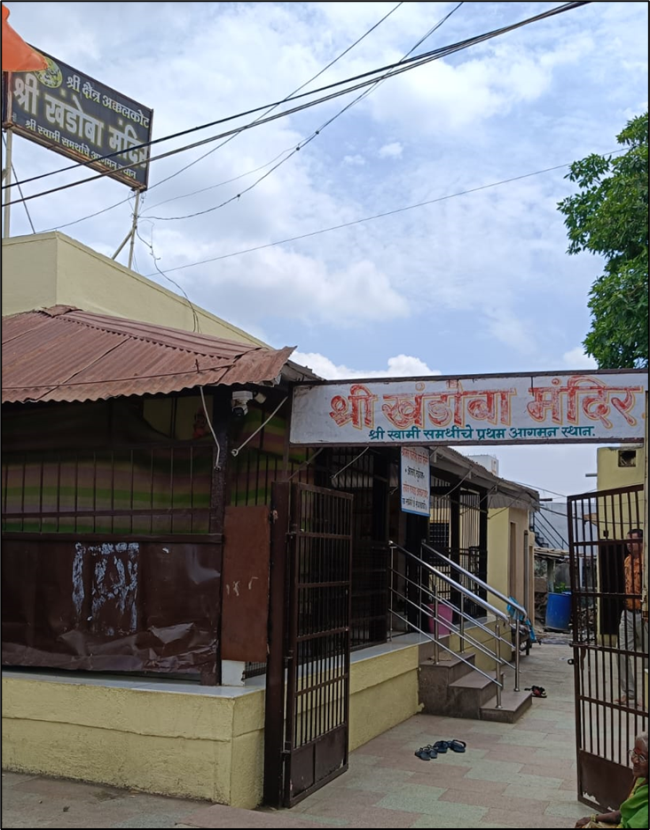
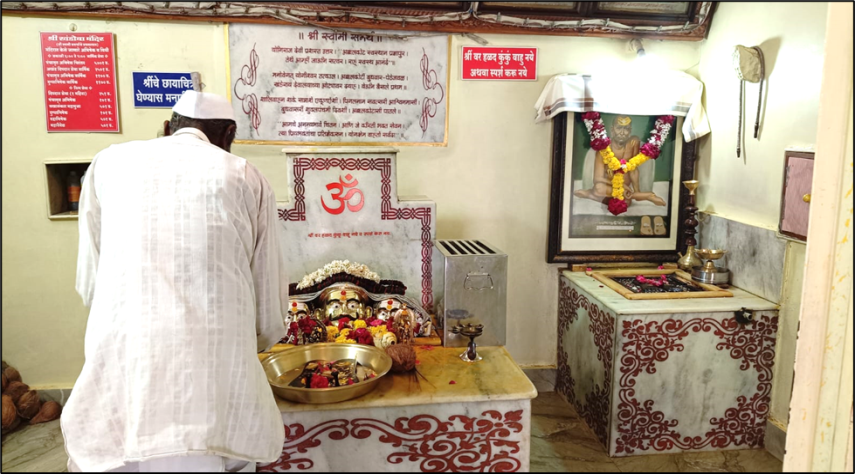
The Mandir was built by Sou. Lakshmibai Bhosale Ranisaheb of Akkalkot, who was a devoted follower of Khanderaya from Jejuri. Ranisaheb frequently visited Tuljapur, Pandharpur, and Jejuri, and envisioned a Mandir for Shri Khandraya in Akkalkot, allowing bhakts easy access to his darshan. During a return trip from Jejuri, she brought three murtis: Shri Khandraya, Mahalsa, and Banabai, and established a small Mandir in a beautiful, dense forest, performing the ritual of Pran Pratishta.
In 1857, during the Lalit Panchani Yatra, Nirguna Nirakar Shri Swami Samarth incarnated in this Khandoba Mandir, joyfully playing with the mukuts (masks) of Shri Khandoba, Mahalsa, and Banabai. Later, these mukuts were moved to the Samadhi Math, where they remain today. After the mukuts were taken to the Samadhi Math, the main murti was worshipped, and new masks were installed 20-25 years ago.
The Mandir also contains the tomb of a horse, given by the King of Akkalkot for Shri Khandraya’s Varat, which took place on a horse during the Champashashti of the Margashirsha month. There is also a tomb for ‘Sundari’, a female monkey that troubled villagers. After receiving complaints, Swami Samarth Maharaj calmed her and asked her not to bite people, after which she never did again. Following her death, Sundari was buried in front of the Mandir.
Another notable story involves a fakir named Ahmad Ali Khan Risaildar, who witnessed Swami Maharaj’s first miracle. He mocked Maharaj by placing an empty chillum (a traditional clay pipe) in his mouth. To everyone’s astonishment, smoke and fire erupted from the empty chillum as Swami Maharaj created fire from it.
Traditionally, Sri Khanderai Hanamant Gurav and Srishail Bhavani Gurav serve as the priests, maintaining the Mandir and performing puja and aarti. The Mandir is well-preserved and has seen significant improvements. Festivals are celebrated with great enthusiasm, featuring Mahapuja, Abhishek, aarti, bhajans, and food donations, drawing many devoted participants who cherish the Akkalkot region.
However, many remain unaware of this important site, which holds great significance as the location where Swami Samarth Maharaj first arrived and began his divine leela.
Shri Sangameshwar Mandir
The Mandir, situated at the convergence of the Bhima and Sina rivers in Kudal Hattarsang village, dates back to the Chalukya period and features a ‘trikuta’ structure, comprising three sacred areas for worship. This architectural design enables bhakts to engage in various forms of worship within a single complex, enhancing its importance as a spiritual site. The historical significance, combined with its serene riverside setting, makes it a popular destination for those seeking spiritual fulfillment.


At the center of the Mandir is the main garbhagriha, which houses a magnificent Shivling along with the murti of Shri Sangameshwara, drawing many bhakts, who come to offer their prayers and seek blessings. It not only serves as a center of worship but also as a symbol of the rich traditions of the region, inviting visitors to immerse themselves in its history and tranquility. There is also an inscription dating back to 1018 CE; according to Mr. Anand Kumbhar, a specialist in inscriptions, it is the first-ever inscription in the Marathi language. It reads ‘vaachi to vijeyaa hoivaa’, meaning ‘whoever reads this will be victorious’.
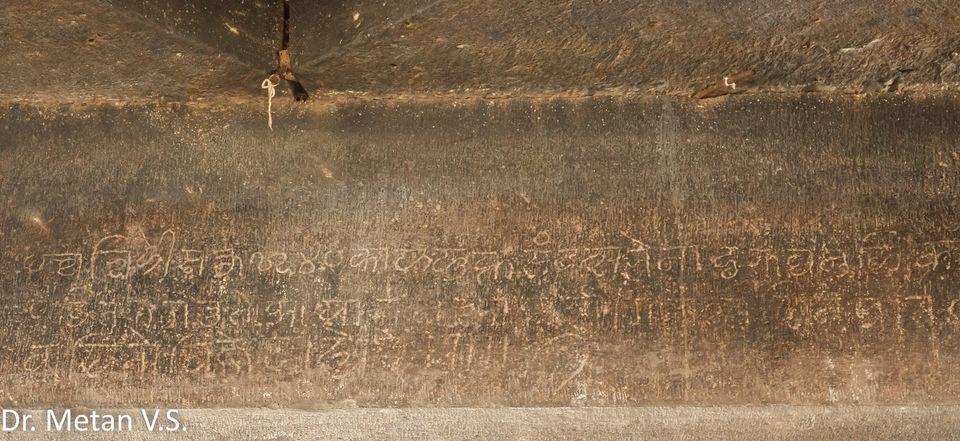
Shri Vitthal Rukmini Mandir
The Shri Vitthal Rukmini Mandir is located on the tranquil banks of the Bhima River in Pandharpur. This Mandir, a prominent shraddha pitha for Varkari devotees, is dedicated to Vitthal, another form of Shri Krishna.
Pandharpur, located in Solapur, is a well-known yatra site. It is often associated with the saying, “Jevha hote charachar, tevha hote Pandharpur”, meaning, “When all living and non-living beings are worshipped, that is when Pandharpur is realized”. This reflects the belief that devotion encompasses all forms of existence, leading to an experience of divine presence. Recognized as the spiritual capital of Maharashtra, Pandharpur attracts pilgrims from across the region, serving as a prominent center of faith and spirituality.
![The Vitthal Rukmini Mandir, located in Pandharpur, is one of the most famous yatra sites in Solapur.[18]](/media/culture/images/maharashtra/solapur/cultural-sites/the-vitthal-rukmini-mandir-located-in-_Evhmogi.png)
The town bursts into life during festivals like Ashadhi and Kartiki Ekadashi, when pilgrims gather in large numbers to celebrate with devotion and vibrant chants. Close to the Vitthal Mandir lies the Pundalik Mandir by the Chandrabhaga River, enriching the town’s spiritual significance. Together, these mandirs establish Pandharpur as a hub of Maharashtra’s cultural heritage and devotion.
The original mandir dates back to King Vishnuvardhana of the Hoysala Empire (1108-52 CE), believed to have been inspired by Pundalika. An inscription by Vira Someshwara in 1237 CE granted a village for its upkeep. Initially built in Hemadpanti style during the 13th century, the Mandir suffered significant damage but retained structures like the Namdev gate. The Vitthal murti was relocated to Vijaynagar in the late 15th century and returned early in the 16th century. Vitthal is also called the “Kanada Raja Pandharicha,” referring to him as the Kannada King of Pandharpur. The present-day structure, showcasing Deccan-style architecture, emerged in the 17th century with contributions from the Peshwas of Pune, Shindes of Gwalior, and Holkars of Indore. Its interiors feature striking elements such as the wooden quadrangle with deep malas and the exquisite Sola Khambi hall with 16 ornate pillars. The Mandir complex hosts various devasthans, including Rukmini Devi, Bhagwan Narasimha, Devi Mahalakshmi, and others.
![The murti of Vitthal in the Vitthal Rukmini Mandir[19]](/media/culture/images/maharashtra/solapur/cultural-sites/the-murti-of-vitthal-in-the-vitthal-ru_44lDG3H.png)
Pandharpur holds immense importance in the Bhakti Movement, particularly through the Varkari sect in Maharashtra and the Haridasa sampradaya in Karnataka. Sants like Dnyaneshwar, Tukaram, Chokamela, Savta Mali, Janabai, and Namdev have been instrumental in spreading Vitthal’s worship. Notably, in 2014, the Mandir made history by inviting women and individuals from backward classes to serve as priests.
Vatavruksha Shri Swami Samartha Maharaj Mandir
Located in Akkalkot, Vatavruksha Shri Swami Samartha Maharaj Mandir is closely associated with Swami Samarth, one of the most revered figures in the Dattatreya tradition. The Mandir derives its name from the banyan tree (vatavruksha) under which Swami Samarth took samadhi in 1878. According to legend, when a disciple once asked about his origins, Swami Samarth answered that he had emerged from a banyan tree. On another occasion, he referred to himself as Nrusimha Bhan.
![Women around the banyan tree at the Swami Samarth Maharaj Mandir in Akkalkot, Solapur, during the occasion of Vat Poornima.[20]](/media/culture/images/maharashtra/solapur/cultural-sites/women-around-the-banyan-tree-at-the-sw_Yp1adOL.png)
Swami Samarth is believed to be a form of Shri Dattatreya and is also regarded as an incarnation of Narasimha Saraswati, another prominent figure in the same tradition. Widely known as Akkalkot Swami, he spent the last twenty-two years of his life in Akkalkot, making it an important pilgrimage destination.
One of the popular legends about his origin connects him to Kardalivan. It is said that when Narasimha Saraswati’s time on Earth was complete, he sat on a flower-filled boat and traveled to Kardalivan, foretelling that the flowers would return against the river’s flow, marking his departure. Three hundred years later, in the same forest, a woodcutter accidentally struck a tree, causing it to bleed. From that tree, Swami Samarth emerged tall, radiant, with unusually long limbs. The terrified woodcutter was reassured by Swami that this was part of his divine journey.
Although mainly associated with Maharashtra, Swami Samarth is believed to have traveled widely across India and other regions, recognized by different names in different places. Upon his samadhi in Akkalkot, legend holds that his soul split in two, one part merging with the vatavruksha, making it a focal point of devotion. Even today, on Rakhi Poornima, devotees tie red threads to the banyan tree in homage to Swami Samarth.
The ashram at Akkalkot remains an active site of worship, drawing thousands of devotees throughout the year. A well nearby, once saline, is remembered for turning sweet after Swami Samarth poured a jar of water into it, a miracle cherished by followers. Thursdays and Poornima days witness particularly large gatherings, with long queues often spilling into the streets.

Veer Tapasvi Math
Veer Tapasvi Math, located in Karnik Nagar, Solapur city, was established in 1957 by Veer Tapasvi Channaveer Shivacharya Mahaswamiji, and is named in his honor. It is associated with the Kannada community.
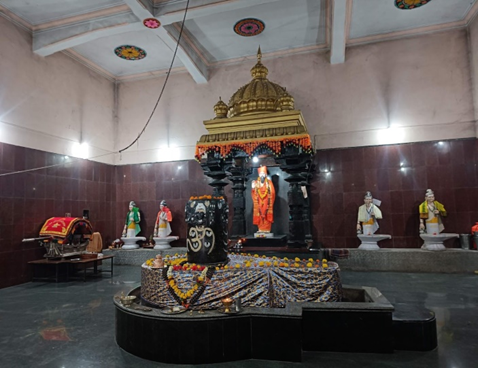
Home to around 1008 Shivlings and a towering 108 ft. murti of Pandit Aaradhya, the math sees a surge of one to two lakh devotees during Mahashivratri. It celebrates all Hindu festivals and traditions. Nearby, one can find other maths in Dhanali, Dhotri, Hotgi, Boramani, Limbi Chincholi, and Khanapur.
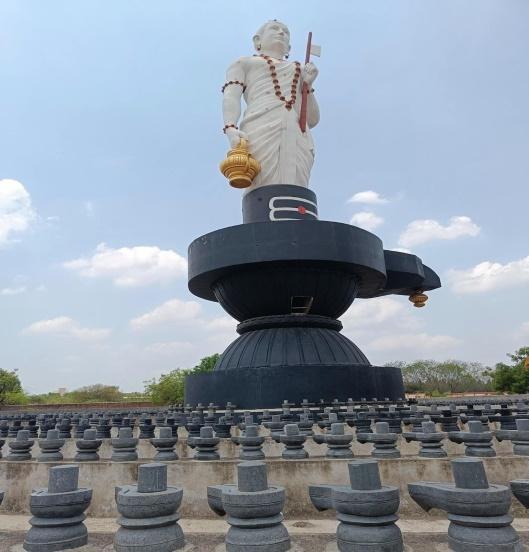
In addition to its spiritual offerings, the math features a public library, the 1008 Jagat Guru Wachnalay, in Purva Mangalwar Peth, and an Annachatra that serves prasad to about 1000 people daily. Devotees frequently donate grains and money. The math also operates 15-16 schools in the district, along with a math school in Delhi.
Sources
ABP Marathi. 2016. Gramdaivat Akluj: Akalai Mata. ABP Marathi.https://marathi.abplive.com/news/gramdaivat-…
Beautiful & Ancient Shri Sangmeshwar and Shri Harihareshwar Temple, Kudal Sangam Hattarsang, Solapur. 2021. Tripoto.https://www.tripoto.com/profile/drvyankatesh…
Dhaval Kulkarni. 2023. ‘When archaeologists found pre-historic era storage pits in Maharashtra’s Solapur’. India Today.https://www.indiatoday.in/india-today-insigh…
Fatehsinh Mahal. Royal Family Akkalkot.https://royalfamilyakkalkot.com/fatehsinh-ma…
Hanumant Shankar Helakar and D. G. Shinde. 2022. Wadwal: A Neglected Religious Tourism Place – A Geographical Study. International Journal of Food and Nutritional Sciences (IJFANS). Vol. 11, Issue 11.https://www.ijfans.org/uploads/paper/3a13720…
Incredible Heritage. Hattarsang Kudal: A Cultural and natural tourist destination. Incredible Heritage.https://incredibleheritage.com/2023/05/10/ha…
Loksatta Team. 2025. सोलापूर : सांगोल्यातील महीम गावी यादवकालीन मंदिराला दान केल्याचा शिलालेख, पुण्यातील अभ्यासकांकडून वाचन. Loksatta.https://www.loksatta.com/maharashtra/solapur…
Machnur. Trekshitz.https://trekshitiz.com/marathi/Machnur-Trek-…
Satyaagrah. 2023. Bahumukhi Temple. https://mail.satyaagrah.com/sanatan/temple/3…
Save Indian Cows. History of Agnihotra. Save Indian Cows.https://saveindiancows.org/agnihotra-history/
Sri Vitthal Rukmini Mandir, Pandharpur. Trawell.https://www.trawell.in/maharashtra/pandharpu…
Vishwa Global. Shivpuri.https://paramsadguru.vishwaglobal.com/shivpu…
Vyankatesh Metan. 2021. Beautiful Ancient Shri Sangmeshwar and Shri Harihareshwar Mandir, Kudal Sangam, Hattarsang, Solapur. Tripoto.https://www.tripoto.com/trip/beautiful-ancie…
Last updated on 6 November 2025. Help us improve the information on this page by clicking on suggest edits or writing to us.